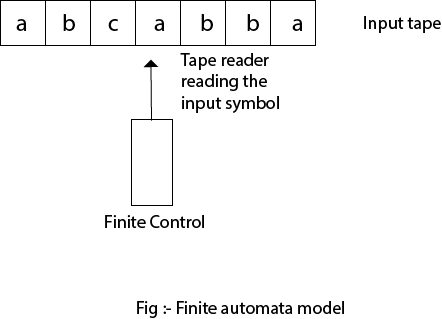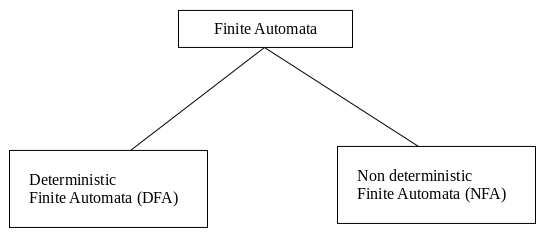TOC-Short
| TOC | Formal Languages | Finite Automata | Regular Grammar | Context Free Languages | Pushdown Automata | Context Sensitive Language | Turing Machines |
Finite Automata
Finite automata is an abstract computing device. It is a mathematical model of a system with discrete inputs, outputs, states and a set of transitions from state to state that occurs on input symbols from the alphabet Σ.
The term finite is used because the number of possible states and the number of elements in the input Σ, both are finite. It is a good model for computer with limited amount of energy.
Finite automata is defined as a 5-tuples
M=(Q, Σ, δ,q0,F)
Where,
- Q: Finite set called states.
- Σ: Finite set called alphabets.
- δ: Q × Σ → Q is the transition function.
- q0 ∈ Q is the start or initial state.
- F: Final or accept state.


Finite automata can be represented by input tape and finite control.
Input tape: It is a linear tape having some number of cells. Each input symbol is placed in each cell.
Finite control: The finite control decides the next state on receiving particular input from input tape. The tape reader reads the cells one by one from left to right, and at a time only one input symbol is read.

Model of finite automata


Deterministic Finite Automata
DFA refers to deterministic finite automata. Deterministic refers to the uniqueness of the computation. In the DFA, the machine goes to one state only for a particular input character. DFA does not accept the null move.
Acceptance by Finite Automata

Example for Acceptance of FA

Non-Deterministic Finite Automata
NFA stands for non-deterministic finite automata. It is used to transmit any number of states for a particular input. It can accept the null move.
Difference Between NFA and DFA?
| Deterministic Finite Automata | Non-Deterministic Finite Automata |
|---|---|
| Each transition leads to exactly one state called as deterministic | A transition leads to a subset of states i.e. some transitions can be non-deterministic. |
| Accepts input if the last state is in Final | Accepts input if one of the last states is in Final. |
| Backtracking is allowed in DFA. | Backtracking is not always possible. |
| Requires more space. | Requires less space. |
| Empty string transitions are not seen in DFA. | Permits empty string transition. |
| For a given state, on a given input we reach a deterministic and unique state. | For a given state, on a given input we reach more than one state. |
| DFA is a subset of NFA. | Need to convert NFA to DFA in the design of a compiler. |
| δ : Q × Σ → Q For example − δ(q0,a)={q1} | δ : Q × Σ → 2 to the power Q For example − δ(q0,a)={q1,q2} |
| DFA is more difficult to construct. | NFA is easier to construct. |
| DFA is understood as one machine. | NFA is understood as multiple small machines computing at the same time. |
Equivalence of DFA and NDFA
DFA to NDFA

NDFA to DFA

Moore and Mealy machines
These are called finite auomata with output where as DFA and NDFA are known as finite automata without output.
Both moore and mealy machine are determinstic.
Mealy Machine
A Mealy Machine is an FSM whose output depends on the present state as well as the present input.
Output length should be
nwhere is length of input string.
It can be described by a 6 tuple (Q, ∑, ▲, δ, λ, q0) where −
- Q is a finite set of states.
- ∑ is a finite set of symbols called the input alphabet.
▲is a finite set of symbols called the output alphabet.- δ is the input transition function where δ: Q × ∑ → Q
λis the output transition function whereλ: Q × ∑ → ▲- q0 is the initial state from where any input is processed (q0 ∈ Q).
Moore Machine
Moore machine is an FSM whose outputs depend on only the present state.
Output length should be
n+1where is length of input string.
A Moore machine can be described by a 6 tuple (Q, ∑, ▲, δ, λ, q0) where −
- Q is a finite set of states.
- ∑ is a finite set of symbols called the input alphabet.
Ois a finite set of symbols called the output alphabet.- δ is the input transition function where δ: Q × ∑ → Q
λis the output transition function whereλ: Q → ▲- q0 is the initial state from where any input is processed (q0 ∈ Q).
Equivalence of Moore and Mealy machine
Minimization of Finite Automata
The term minimization refers to the construction of finite automata with a minimum number of states, which is equivalent to the given finite automata. The number of states used in finite automata directly depend upon the size of the automata that we have used. So, it is important to reduce the number of states. We minimize the finite automata by detecting those states of automata whose presence or absence does not affect the language accepted by the finite automata.
Some important concepts used in the minimization of finite automata
- Unreachable state
- Dead State
Unreachable state: Unreachable state is that state in which finite automata never reaches during the transition from one state to another state.

In the above DFA, we have unreachable state E, because on any input from the initial state, we are unable to reach to that state. This state is useless in finite automata. So, the best solution is to eliminate these types of states to minimize the finite automata.
Dead State: It is a non-accepting state, which goes itself for every possible input symbol.

In the above DFA, we have q5, and q6 are dead states because every possible input symbol goes to itself.
The following steps are used to minimize a Deterministic Finite Automata.
-
Step1: First of all, we detect the unreachable state.
-
Step2: After detecting the unreachable state, in the second step, we eliminate the unreachable state (if found).
-
Step3: Identify the equivalent states and merge them.
- In this, we divide all the states into two groups:
- Group A: This group contains all accepting states of automata.(final state)
- Group B: This group contains all non-accepting states of automata.(non final state)
-
This step is repeated for every group. Find group the input lead to if there are differences the partition the group into sets containing states which go to the same groups under the inputs.
- The resulting final partition contains equivalent states now merge them into a single state.
-
Step4: In this step, we detect dead states.
- Step5: After detecting the dead states, the last step is to eliminate dead states.
Applications and limitations of Finite Automata
Application
- For the designing of lexical analysis of a compiler.
- For recognizing the pattern using regular expressions.
- For the designing of the combination and sequential circuits using Mealy and Moore Machines.
- Used in text editors.
- For the implementation of spell checkers.
Limitation
Some important points about DFA and NFA:
- Every DFA is NFA, but NFA is not DFA.
- There can be multiple final states in both NFA and DFA.
- DFA is used in Lexical Analysis in Compiler.
- NFA is more of a theoretical concept.
Good Reference: Link
| TOC | Formal Languages | Finite Automata | Regular Grammar | Context Free Languages | Pushdown Automata | Context Sensitive Language | Turing Machines |